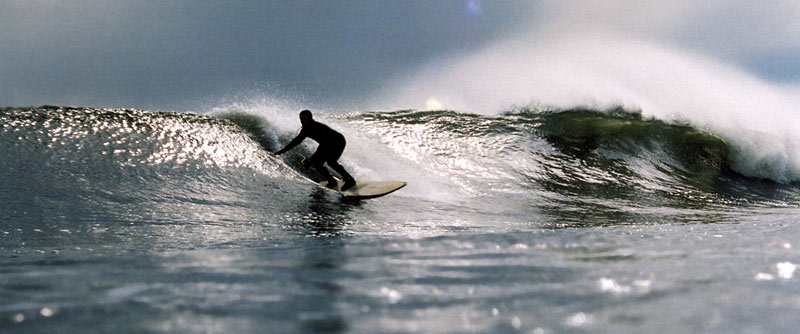In 2005, the city Department of Parks and Recreation officially designated Beach 90th as a surfing beach. Prior to that time, surfers faced fines and confiscation of their equipment. But overnight, the mantra of “New York City’s only surfing beach” became a citywide phenomenon that has led to an explosion in the seasonal surfing population.
The Storm Rider Guide to North America, an illustrated guide to the Nation’s surf destinations, lists Rockaway as the closest surfing beach to Manhattan. It also warns that the crowds are more challenging than the waves. The best section of Rockaway “breaks” next to a dangerous stone jetty. When the surf is up, riders will jockey for position right in front of this formidable coastal structure. This means that on summer days when the waves are good, more than 40 surfers will be fighting over a section of water roughly the size of a living room in the East Village. Over 200 more will be scattered around in the water in an area just four blocks wide.
“If it’s a good day in July, people come down here from all over the city,” says Christian. “The city says this is the only surfing beach. Then you only give these 200 to 300 surfers four blocks? All order in the lineup is discarded.” If surfers stray outside the boundaries of the surf beach, they face the harassment of the local Rockaway lifeguards. This summer the city designated a second surfing beach in Rockaway at 67th Street to alleviate the congestion at 90th Street. But even so, many new residents who surf have claimed 90th Street as their own, prompting a jealous backlash from the more entrenched community, expressed in the form of behavior known in the surfing world as “localism.”
“In the beginning, three to four years ago, there was a lot of localism going on,” says Christian. “We tried to get people to respect the lineup as it was, but eventually there were too many people for a lineup.” The lineup refers to a group of surfers out in the water and the politics that surrounds catching waves. Movies like Blue Crush have recently popularized surfing, resulting in a rush of newcomers who know relatively little about the etiquette of surfing. These neophyte surfers pose a threat to themselves and others in the water because of their inexperience.
“There were sometimes threats of violence,” says one Rockaway local who chose to remain anonymous. “There would sometimes be guys that, if you dropped in on them [took their wave], they would wait on the shore to beat you up.”
“Localism seems gone now,” says Christian. He notes that the last five years have brought not only commuters, but hundreds of new permanent residents, many of them renting houses between 87th and 94th street, directly around Boarders of Rockaway. If Boarders is the epicenter, many surfers have taken the Stathises’ example and decided to move down to Rockaway from elsewhere in the city to be closer to the waves.
“It used to be, if you can’t see your house from the water, then you had no business here,” says Christian. “But now things are different. A big building like an apartment complex on Holland Avenue houses about 1,100 people. If one percent of those residents surf, that’s 11 new people in the water.”
Many longtime Rockaway surfers have given up on Beach 90th Street, with its mob scenes, new locals and super-packed summer lineups. “There are, simply put, too many surfers,” says a local surfer, who chose to remain anonymous for fear of being looked down upon by his Rockaway contemporaries.
“I don’t get stressed,” says Fernando “Fern” Pires, a Rockaway resident for more than 20 years. Although many longtime locals have abandoned the surf spot, he still surfs Beach 90th Street, which is about two blocks from his home. “There are waves all over this beach from Beach 90th all the way to Breezy Point. But people come to 90th because that’s where the action is. The waves break well here, and I’m familiar with the workings of the sand bar. Why would I move?”
Fern moved to the US from Brazil in 1980. He started surfing when he was 13, and hasn’t ever stopped. “I was in Flushing first, and after 2 weeks I started asking where the beach was. Back then we surfed Beach 38th Street. Bust then the [sandbar] changed. People started talking about Beach 90th street, and I ended up moving there in 1983.” Thirteen years later, Fern still lives and surfs at Beach 90th Street.
“Surfing is a part of my life that I couldn’t live without. I go in the water to find myself. People have the faith that going in the water will make you stronger. Surfing has always been something positive in my life.”

